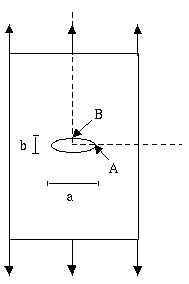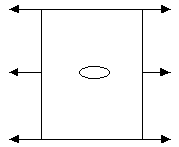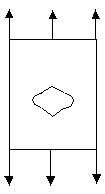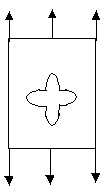|
|
Who started all this fracture mechanics stuff?
|
|
In 1913, a man named C.E. Inglis looked at a thin plate of glass (?) with
an elliptical hole in the middle in a new and different way. Theoretically,
the plate was infinitely large and the hole very small in comparison. The
plate was pulled at both ends perpendicular to the ellipse.
He found that point A, at the end of the ellipse, was feeling the most
pressure. He also found that as the ratio of a/b gets bigger (the ellipse
gets longer and thinner) that the stress at A becomes greater and greater.
|
 |

|
He also found that pulling on the plate in a direction parallel to the
ellipse does not produce a great stress at A. This leads to the fact
that a load perpendicular, not parallel, to the crack will make it grow.
Try it yourself!
|
|
Then he looked at other plates with not-quite-elliptical holes, like these.
From looking at these he realized that it's not really the shape of the hole
that matters in cracking. What matters is the length of the crack that is
perpendicular to the load and what the radius of curvature at the ends of the
hole is. The longer the hole (or crack), the higher the stress, and the
smaller the radius of curvature, the higher the stress.
|
 |
 |
Then, in the 1920's, a man named A.A. Griffith extended Inglis' work.
Griffith thought again about the infinite plate under tension, but he
stretched the ellipse out into a crack. He did some experiments too.
|
|
His first experiment was on a soft iron wire, 100 inches long and 0.028
inches in diameter. He pulled on this wire until it yeilded.
Then he took another wire with the same dimensions and put very small
fractures, scratches, on it spirally. He pulled on this wire until it
yielded. The scratched wire had only a quarter of the strength of the
unscratched wire. He concluded that the scratches increased the stress in
the wire by 3 or 4 times which made it yield earlier. |

|
|
He also tested a thin plate of glass, pulled in tension, with a crack in the
middle perpendicular to the load. He found that the stresses at the ends
of the crack were very high and the crack weaked the glass significantly.
From these two tests he concluded that materials that are fractured, no matter
how small the fracture, act much differently than the same material that is
without cracks!
Griffith also introduced the notion of energy sources and sinks in crack
propagation which was mentioned earlier. He
said that for a crack to grow, it was necessary for their to be enough
potential energy in the system to create the new surface area of the crack.
He did not know that it takes more than this for a crack to grow though.
That's all for now. Other contributors to fracture mechanics to come:
Westergaard
Irwin
Williams
Sih
Liebowitz
Rice
Ingraffea (#), Cornell University
Saouma (#), University of Colorado at Boulder
Dodds (#), University of Illinois at Urbana-Champaign
|
You have reached the end
of the Cracks section!
Please visit the Dams, Case Histories,
Scenarios, or Simulation section by choosing from the side menu.
|


|




